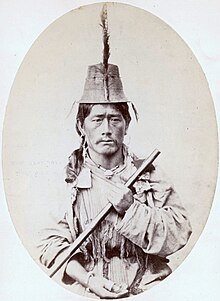 A Lepcha man in 1868 | |
| Total population | |
|---|---|
| 80,316 (2011) | |
| Regions with significant populations | |
| 76,871 (2011 census)[1] | |
| 3,445 (2011 census)[2] | |
| N/A | |
| N/A | |
| Languages | |
| Lepcha, Sikkimese (Dranjongke), Dzongkha, Nepali | |
| Religion | |
| Buddhism (Majority), Mun, Christianity[3][4] | |
| Related ethnic groups | |
| Tibetan, Bhutia, Limbu, Lhop, Other Sino-Tibetan people | |
The Lepcha (/ˈlɛptʃə/;[5] also called Rongkup (Lepcha: ᰕᰫ་ᰊᰪᰰ་ᰆᰧᰶ ᰛᰩᰵ་ᰀᰪᰱ ᰛᰪᰮ་ᰀᰪᰱ, Mútuncí Róngkup Rumkup, "beloved children of the Róng and of God") and Rongpa (Sikkimese: རོང་པ)) are among the indigenous people of the Indian state of Sikkim and Nepal, and number around 80,000.[1][2] Many Lepcha are also found in western and southwestern Bhutan, Darjeeling, the Koshi Province of eastern Nepal, and in the hills of West Bengal. The Lepcha people are composed of four main distinct communities: the Renjóngmú of Sikkim; the Dámsángmú of Kalimpong, Kurseong, and Mirik; the ʔilámmú of Ilam District, Nepal; and the Promú of Samtse and Chukha in southwestern Bhutan.[6][7][8]
- ^ a b ORGI. "A-11 Individual Scheduled Tribe Primary Census Abstract Data and its Appendix". www.censusindia.gov.in. Office of the Registrar General & Census Commissioner, India. Retrieved 20 November 2017.
- ^ a b "National Population and Housing Census 2011" (PDF). UN Statistical Agency.
- ^ Semple 2003, p. 233
- ^ Joshi 2004, p. 130.
- ^ "Lepcha". Random House Webster's Unabridged Dictionary.
- ^ Plaisier 2007, p. 1–2.
- ^ SIL 2009.
- ^ NIC-Sikkim.